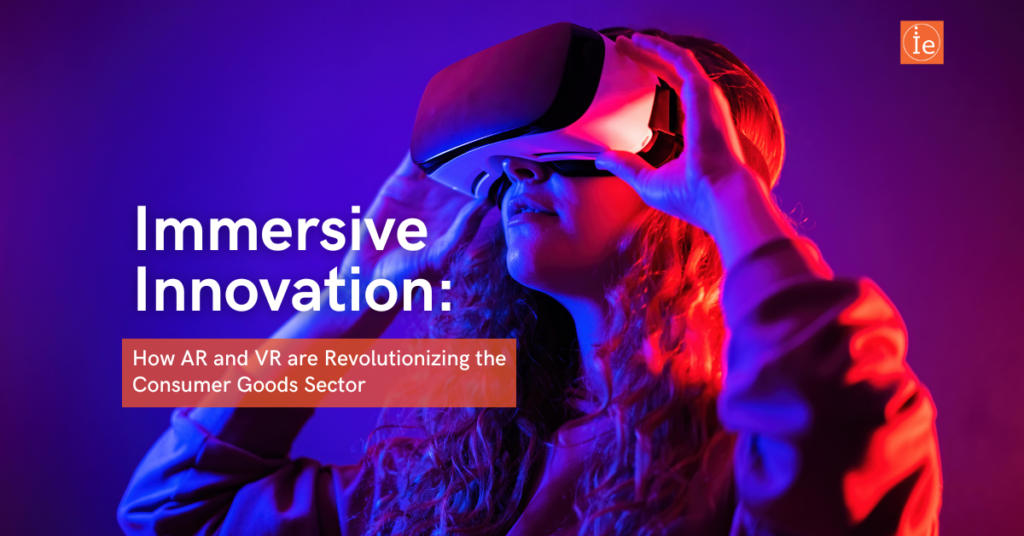
Are you ready for the immersive future of business? Today, the line between the physical and virtual world is becoming increasingly blurred, thanks to the rapid advancement of Augmented Reality (AR) and Virtual Reality (VR) technologies. These innovations are not just reshaping entertainment–they’re revolutionizing how we shop, learn, and interact with the world around us and the products we use every day.
As companies strive to enhance customer experiences and drive innovation, AR and VR emerge as powerful tools in their arsenal. Discover how leading companies are leveraging AR and VR to enhance customer experiences and drive innovation.
Understanding AR and VR in the Consumer Goods Sector
AR overlays digital information onto the real world (ie: a mechanic being able to see repair instructions directly overlaid on an engine, making complex tasks easier to understand and execute), while VR creates a completely immersive digital environment (ie: a homebuyer being transported into a 3D walkthrough of a house thousands of miles away, providing an immersive tour without leaving their current location).
While AR enriches our perception of reality, VR transports us to entirely new worlds, offering distinct but complementary experiences. In the consumer goods sector, these technologies have moved from experimental to essential, driven by technological advancements and changing consumer expectations.
The rapid rise of AR and VR in this sector is a testament to innovation. Initially used for niche applications, they’ve become mainstream, thanks to the proliferation of smartphones and the increased processing power of computers. Today, these technologies not only captivate consumers but also offer tangible benefits to businesses, from enhanced customer engagement to streamlined product development. Throughout this article, we’ll explore the transformation in consumer goods through the lens of AR and VR technologies, emphasizing how these tools offer unparalleled product experiences.
Related: Ahead of the Curve: Predicting the Consumer Landscape in 2024
Enhancing Customer Experiences
One of the most visible impacts of AR and VR is on customer experiences. Virtual try-ons and showrooms are perhaps the most relatable examples. Furniture companies, like IKEA, leverage AR to let customers visualize how products will look in their homes by using their mobile devices.
Similarly, fashion and beauty brands use AR for virtual try-ons, allowing customers to see how clothes or makeup products look on them without physically trying them on. Interactive product demonstrations take this a step further, providing consumers with an in-depth look at new features and capabilities. For instance, some car manufacturers use VR to offer immersive experiences that allow customers to explore a car’s interior or simulate driving in various conditions. This level of interaction goes beyond traditional marketing, offering a compelling narrative that engages customers on a much deeper level.
Personalization also plays a crucial role in modern retail, and AR and VR are at the forefront of this trend. By analyzing customer interactions and preferences, these technologies offer personalized shopping experiences that were unimaginable a few years ago. From customized product recommendations to guided virtual store maps, AR and VR are setting new standards for customer engagement.
Related: Revolutionizing Retail: How AI Powers Consumer Goods Companies
Driving Operational Innovation and Efficiency
Beyond customer-facing applications, AR and VR are revolutionizing operations in the consumer goods sector. In product development, for instance, these technologies enable designers and engineers to prototype and iterate faster. Virtual prototypes can be created and modified at a fraction of the cost and time required for physical prototypes, accelerating the innovation cycle.
Supply chain operations also benefit from AR and VR. Warehouse workers are using AR for hands-free operations, which in turn increases efficiency and reduces errors. Similarly, employers are using VR to elevate on-the-job training, preparing employees for real-world scenarios without the associated risks or costs we’ve seen in the past.
Behind the scenes, these new technologies are speeding up product development across industries. Market research has traditionally relied on surveys and focus groups, but AR and VR offer new possibilities. By tracking how users interact with virtual products, companies can gain insights into consumer preferences and behavior, enabling data-driven decision-making that aligns closely with current market needs.
Related: The 7 Success Factors That Lead to Transformational Change
The Road Ahead: Continuing the Journey with AR and VR
As we journey through the immersive landscape of AR and VR in the consumer goods sector, it’s evident that these technologies are not just shaping the future—they’re redefining it. From transforming customer experiences to driving operational efficiency, AR and VR are unlocking new possibilities and pushing the boundaries of innovation.
But our exploration doesn’t end here. In part two of this series, we’ll delve deeper into real-world examples of companies that have successfully integrated AR and VR into their processes. Stay tuned as we uncover the innovative strategies and impactful outcomes that await those who dare to embrace the immersive future of business.
Additional Resources
- How VR is Transforming the Way We Train Associates by Jane Incao, Walmart Today
- Walmart and VR training by Anastasia Morozova, COO at Jasoren
- In the footsteps of trailblazers: How Walmart embraces Immersive Learning, STRIVR
- Ikea tests virtual reality with new ‘kitchen experience’ app by Jason Ankeny, RetailDive
- Augmented Reality in Books and Publications, Kotobee
- Using Augmented Reality for Teaching Earth-Sun Relationships to Undergraduate Geography Students by Shelton, B. E., & Hedley, N. R., The First IEEE International Workshop Augmented Reality Toolkit
- Cover Story: Christoph Niemann’s “On the Go” by Françoise Mouly and Mina Kaneko, The New Yorker
- What Are Augmented Reality Books? By Rachael, Draw & Code
- Augmented Reality Is Already Changing Healthcare For The Better by Ari Grobman, Forbes
- Augmented Reality in Medicine: Systematic and Bibliographic Review, JMIR Mhealth Uhealth
- Augmented Reality in Real-time Telemedicine and Telementoring: Scoping Review, JMIR Mhealth Uhealth
